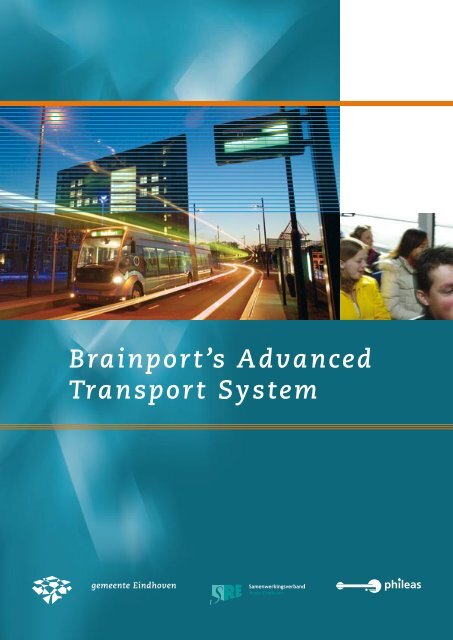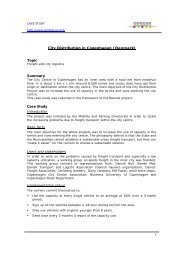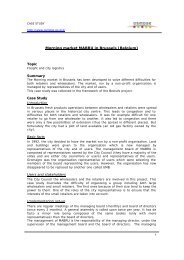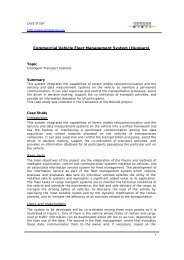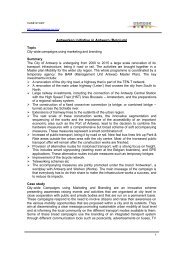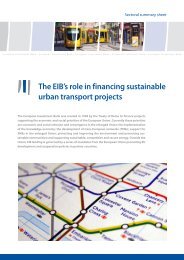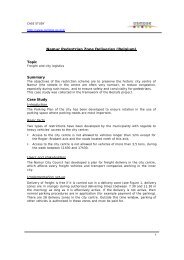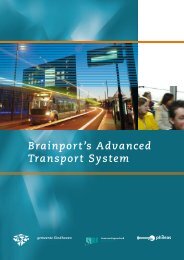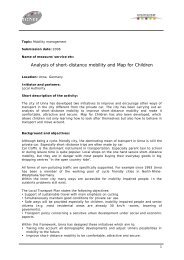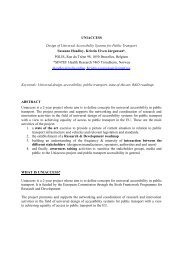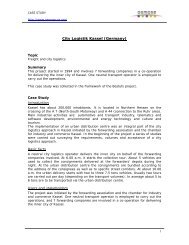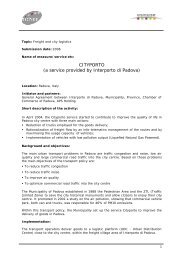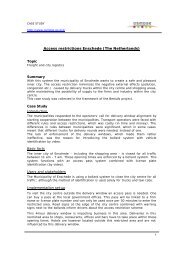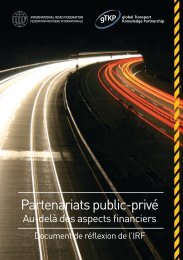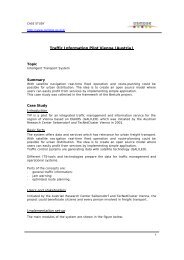Brainport's Advanced Transport System - Eindhoven
Brainport's Advanced Transport System - Eindhoven
Brainport's Advanced Transport System - Eindhoven
Create successful ePaper yourself
Turn your PDF publications into a flip-book with our unique Google optimized e-Paper software.
Brainport’s <strong>Advanced</strong><br />
<strong>Transport</strong> <strong>System</strong>
Ambition and motivation<br />
<strong>Eindhoven</strong>, the fifth largest city of The<br />
Netherlands, is a real hot spot for technology.<br />
As center of the Brainport region, it is called<br />
the research capital of The Netherlands.<br />
Our ambition is to excel as an international top<br />
technology region. Already we are competing in<br />
Europe’s top five of innovative regions.<br />
In the mid nineties of the last century we<br />
found ourselves in a totally different situation.<br />
The region went through an economic dip due<br />
to massive lay offs in big companies like Philips<br />
and DAF. We then realized it was necessary to<br />
find a way to prevent this from happening<br />
again. So knowledge and forces were joined<br />
together in the Triple Helix, a strong<br />
cooperation that is based on the combined<br />
strengths and responsibilities of business,<br />
public authorities and knowledge institutes.<br />
Today our economy is booming again. One of<br />
the consequences of this success is the growing<br />
supply of traffic and the increasing pollution<br />
of <strong>Eindhoven</strong>’s air quality. With that in mind,<br />
Phileas was developed. A result of joined<br />
development between Triple Helix partners,<br />
Autobusfabriek BOVA B.V. (now VDL-group),<br />
N.V. Brabantse Ontwikkelings Maatschappij<br />
(Ltd BOM), Duvedec International B.V.,<br />
Netherlands Car B.V. Product Design &<br />
Engineering (now APTS), Simac <strong>System</strong>s B.V.,<br />
Neways Electronics B.V, united in the<br />
Foundation Hoogwaardig Openbaar Vervoer<br />
(HOV). They worked closely together with<br />
stakeholders from the municipalities of<br />
<strong>Eindhoven</strong> and Veldhoven,<br />
Samenwerkingsverband Regio <strong>Eindhoven</strong><br />
(SRE-regional cooperation), Hermes Group<br />
(public transport group in the region) and the<br />
Ministries of VROM (Housing and Spatial<br />
Planning), EZ (Economic Affairs) and V&W<br />
(<strong>Transport</strong>, Public Works and Water<br />
Management). The EU contributed to the<br />
preparation of documents and studies through<br />
the Stimulus program. A program, which<br />
intended to restructure and reinforce the<br />
socio-economic base of our region.<br />
The urgency to tackle the problems of<br />
congestion and air quality created Phileas.<br />
Our advanced public transport system, a viable<br />
product, which solves problems and adds to<br />
opening up new business opportunities.<br />
And this is only one result of linking problems<br />
to the strengths of the regional automotive,<br />
electronic and design oriented industry and<br />
knowledge institutes.<br />
Inventing and producing high quality<br />
technological products is one thing, finding<br />
markets and opening them up is another.<br />
But you always need the skill of making and<br />
maintaining contacts. The better you are at<br />
this, the bigger your success; not only in<br />
business but also in your personal life.<br />
As alderman of <strong>Eindhoven</strong>, representing one of<br />
the launching customers in the region, I am<br />
proud to present to you Phileas, a result of<br />
motivated and innovative joined cooperation.<br />
H.J.A. van Merrienboer M Sc<br />
Alderman of the city of <strong>Eindhoven</strong>
1<br />
Main urban transport problems, history<br />
and objectives of urban transport policy<br />
Phileas first line from central station to city<br />
center Veldhoven and to <strong>Eindhoven</strong> airport<br />
<strong>Eindhoven</strong> – the fifth largest city of The<br />
Netherlands – is the Dutch number one<br />
innovation area. Brainport <strong>Eindhoven</strong> scores<br />
already well above the Lisbon Agenda<br />
benchmarks where it concerns R&D and<br />
innovative criteria. It competes in Europe in the<br />
top five of innovative regions. This economic<br />
motor creates economic growth. There is a<br />
growing pull attracting innovative knowledge<br />
intensive enterprises, resulting in growing<br />
congestion problems in the region and the city.<br />
Influx of small sized businesses, their employees<br />
and the accompanying logistics generate more<br />
and more mobility within the city and its<br />
surrounding region. Besides this growing<br />
transport, <strong>Eindhoven</strong> is also situated on two<br />
important international truck routes from the<br />
Randstad Holland (Amsterdam and Rotterdam<br />
and their respective air- and seaports) to the<br />
East and the South of Europe.<br />
The accessibility of the (center) city and its<br />
direct surrounding region is threatened by this<br />
growing supply of traffic. The once transparent<br />
and accessible infrastructure of <strong>Eindhoven</strong><br />
became seriously threatened. The growing traffic<br />
also burdened <strong>Eindhoven</strong>’s air quality of the<br />
(center) city and its direct surrounding region.<br />
History of local transport policy<br />
The once well accessible center of the city<br />
started from the early nineties to be in a similar<br />
situation as a heart suffering from clocked up<br />
arteries. Serious congestion and pollution lead<br />
to economic and health problems. To prevent a<br />
heart attack and asthmatic spasms something<br />
needed to be done.<br />
The first transport measures were to plan and<br />
implement the realization of free bus lanes.<br />
Notwithstanding the fact that this measure as<br />
such created faster movement of buses to and<br />
through the city (center), the use of public bus<br />
transport kept decreasing.<br />
The implementation of a new urban area in the<br />
West Corridor (Meerhoven neighborhood) of at<br />
least 6000 homes, the upgrading of the local<br />
airport and attraction of business on the new<br />
to develop industrial estate Flight Forum<br />
(West), together with the loss of public<br />
transport in favor of even more private car<br />
kilometers, air pollution and health problems,<br />
combined with the strong interest from the<br />
industry to innovate public transport created<br />
the fertile ground for the Phileas <strong>Advanced</strong><br />
Public <strong>Transport</strong> Network concept. The<br />
ambition was to make it one of Europe’s<br />
leading innovative concepts, using a free<br />
infrastructure, with a vehicle easy to board and<br />
accessible for a large group of residents and<br />
commuters.<br />
In 1999 the terms of reference and financial<br />
side of the project were agreed between the<br />
main stakeholders. A milestone for innovation<br />
of public transport 1 .
As the list of stakeholders clearly shows, the<br />
development of the Phileas can be shown as a<br />
hands-on-experience of joined development<br />
between what in Brainport <strong>Eindhoven</strong> is known<br />
as the Triple Helix. A strong cooperation based<br />
on the strengths and responsibilities from<br />
business, public authorities and knowledge<br />
institutes. The urgency to tackle the problems<br />
of congestion, air quality and health in the<br />
region and city, by linking them to the strength<br />
of the regional automotive, electronic and<br />
design industry and knowledge institutes, has<br />
created a viable product, which solves problems<br />
and adds to opening up new business<br />
opportunities.<br />
Objectives of local transport policy<br />
1 To stimulate the public transport within the<br />
city (center) and the direct surrounding<br />
region with a transport concept that could<br />
be further established in the first decades<br />
of the 21st century by:<br />
A Improvement of the bad air quality and the<br />
fear of further air quality reduction because<br />
of growing mobility, specifically in<br />
<strong>Eindhoven</strong>’s city center.<br />
B Reduction of the overall national trend of<br />
growing 2nd car ownership in the<br />
households living in the direct area of service<br />
of the new Phileas APT network system.<br />
C Inverting the trend that the city center<br />
(shops, train station, etc.) becomes less<br />
accessible for residents and commuters from<br />
the new to develop residential and industrial<br />
areas in the West Corridor of the city of<br />
<strong>Eindhoven</strong> and vice versa.<br />
D Inverting the trend of quality cuts in the<br />
local public bus services due to decreasing<br />
profitability because of diminishing numbers<br />
of passengers.<br />
2 To stimulate the public transportation<br />
service (first objective) by taking supportive<br />
policy measures:<br />
A Making the use of private cars less favorable<br />
through increasing the usage costs, which<br />
can be locally influenced.<br />
B Making the transport to and from the APT<br />
network easier and faster.<br />
C Stimulation and developing mobility<br />
management plans for industrial estates.<br />
D Stimulation of the quality of the public<br />
transportation system.<br />
1 Sporen zonder rails; Plan van Aanpak, Proefproject Hoogwaardig<br />
Openbaar Vervoer Regio <strong>Eindhoven</strong>; stichting Platform HOV; 1996)
2<br />
Innovative Urban transport Measures<br />
Innovative Measure 1:<br />
A cleaner and faster high quality public transport<br />
system, more competitive with the private car.<br />
This implicated terms of reference on 2 :<br />
A Environmental cleanliness.<br />
B Speed and capacity.<br />
C Costs.<br />
D High quality of the vehicle system.<br />
Objectives<br />
A Environmental cleanliness:<br />
1 Reduction of the exhaust to Euro 3 norm for<br />
buses.<br />
2 Hybrid or electric propulsion giving the<br />
ability to run on electric traction for a stretch<br />
of minimal 3 kilometers.<br />
3 Electronic guidance increasing fuel economy,<br />
enabling more accurate and quicker stops,<br />
thus a higher average speed and decreasing<br />
the use of road space.<br />
B Speed and capacity:<br />
1 Average speed on total route of 25 - 30<br />
km/hr.<br />
2 Maximum speed within municipal<br />
boundaries on free infrastructure of at least<br />
70 km/hr and outside these boundaries of<br />
at least 80 km/hr.<br />
3 A transfer time factor (travel time per public<br />
transport divided by travel time per private<br />
car between two points) below 1,5.<br />
4 1000 passengers capacity maximum on<br />
busiest time of the day, on the busiest spot<br />
in the busiest direction.<br />
5 Large passenger capacity leading to a<br />
maximum of travel schedule intervals of 10<br />
minutes.<br />
2 See note 1<br />
3 Global technical decription of Phileas, the solution for High Quality<br />
Public <strong>Transport</strong>; APTS B.V; 2001<br />
C Costs:<br />
1 Costs per kilometer of the free infrastructure<br />
of the <strong>Advanced</strong> Public <strong>Transport</strong> Network<br />
<strong>System</strong> should be between a conventional<br />
bus on a free lane and a fast tram.<br />
2 Reduction of 25% of fuel use compared to<br />
normal bus.<br />
3 Income - cost ratio should be at least 50%,<br />
based on the Dutch public transport budget<br />
reimbursement system.<br />
D High quality of the vehicle system:<br />
1 A quick and easy access for all passengers,<br />
more specifically senior citizens, passengers<br />
who are handicapped, in wheelchairs and<br />
with trolleys for children.<br />
2 An appealing design, which adds to the<br />
public experience.<br />
3 A payment system requiring no interference<br />
of the vehicle operator, contributing to<br />
shorter stops and higher average speed.<br />
4 A vehicle system with a large flexibility from<br />
the infrastructure.<br />
5 A network system that can be extended to<br />
the rest of the <strong>Eindhoven</strong> region.<br />
Initiator(s)<br />
Stichting (foundation) Platform Hoogwaardig<br />
Openbaar Vervoer (HOV).<br />
The foundation is a cooperative of:<br />
• Autobusfabriek BOVA B.V. (now VDL-group).<br />
• N.V. Brabantse Ontwikkelings Maatschappij<br />
(limited BOM).<br />
• Duvedec International B.V.<br />
• Netherlands Car B.V. Product Design &<br />
Engineering (now APTS).<br />
• Simac <strong>System</strong>s B.V.<br />
• Neways Electronics B.V.<br />
They intended to work with the following<br />
stakeholders:<br />
• Stichting Platform HOV;<br />
• Municipalities of <strong>Eindhoven</strong> and Veldhoven;<br />
• Samenwerkingsverband Regio <strong>Eindhoven</strong><br />
(SRE-regional cooperation);<br />
• Public transport group in the region (now<br />
Hermes Group);<br />
• Ministries of VROM (Housing and Spatial<br />
Planning), EZ (Economic Affairs) and V&W<br />
(<strong>Transport</strong>, Public Works and Water<br />
Management).<br />
The EU contributed to the preparation of<br />
documents and studies through the Stimulus<br />
program. A program which intended to<br />
restructure and reinforce the socio-economic<br />
base of the region.<br />
Target groups<br />
• Inhabitants of <strong>Eindhoven</strong> and Veldhoven.<br />
• Employees working in <strong>Eindhoven</strong>.<br />
• Incoming travelers through <strong>Eindhoven</strong><br />
International airport and by train (tourists<br />
and businessmen).<br />
Description<br />
The techniques of the hybrid combustion<br />
engine have been specially tuned for LPG 3 .<br />
It provides direct drive to a liquid cooled<br />
3-phase synchronous permanent magnet, which<br />
feeds the interchange circuit via a rectifier.<br />
The generator is directed by the power demand<br />
of the traction installation, where attempt is<br />
made to keep the inter stage circuit voltage as<br />
constant as possible.<br />
This LPG generator charges a nickel metal<br />
hydride battery and stops when batteries are<br />
fully loaded. On top of that the electro-motors<br />
– which drive the wheels except the two in the<br />
front – use the released energy during braking<br />
to feed to the batteries.
However since the start of Phileas until today<br />
the technical evolution has increased in speed.<br />
Due to the fact that the <strong>Eindhoven</strong> Phileas was<br />
the first in its sort, a real pilot project in the full<br />
sense of the word, several new technical<br />
developments have surpassed the <strong>Eindhoven</strong><br />
Phileas versions.<br />
Currently diesel engines with a Euro 5 norm are<br />
on the market and Euro 6 Diesel engines are<br />
being developed. The newest diesel engines<br />
save 30% of fuel and have a better<br />
environmental performance, as compared to<br />
the normal bus.<br />
The Phileas which has been sold to the French<br />
city of Douai has a more advanced propulsion<br />
system than the <strong>Eindhoven</strong> version and would<br />
qualify for the current EU emission norms.<br />
This version also tackled the safety back up for<br />
the failure of power steering during a situation<br />
when driving emission free.<br />
If future technology allows further<br />
improvements like the use of the gas turbine or<br />
fuel cell, the combustion engine and/or the<br />
complete generator will be replaced by an<br />
alternative energy source.<br />
(Expected) Results<br />
Environmental cleanliness, the results<br />
The current techniques of the hybrid engine<br />
and battery sytem meet the Euro 3 norm easily.<br />
Emissions CO: 0.6 g/kWh – NOx: < 0,4 g/kWh<br />
– CH: < 0,02 g/kWh – particles: < 0,01 g/kWh<br />
The battery management system enable the<br />
Phileas to run 4 kilometers without any<br />
exhaust. This contributes to the improvement of<br />
the air quality, which is so essential in the air<br />
polluted city centers.<br />
The electronic guidance system uses magnetic<br />
markers, placed apart for reference every 4<br />
meters in the road surface. This infrastructure is<br />
rather flexible compared with tracks of a tram<br />
for instance. When a route needs temporarily<br />
deviation, it’s possible to install magnets and<br />
adjust the software in one day.<br />
4 Monitoring HOV SRE; report Mobicon 2006<br />
The guidance system proves to be very accurate<br />
and enables Phileas to drive in a straight line,<br />
stop automatically at a guaranteed distance<br />
from the station platform (curb) and provide a<br />
constant information between the vehicle and<br />
the control room of the transit organization and<br />
vice versa. This is essential for accurate<br />
passenger information on station platforms,<br />
in the Phileas and the control room.<br />
In combination with the all wheel traction<br />
(except front wheels) and all wheel steering,<br />
the Phileas needs less space then a tram or<br />
multi segmented bus. Lanes can be smaller and<br />
curves less wide, thus saving on construction<br />
costs.<br />
Speed and capacity, the results<br />
The transfer time factor has been decreased<br />
from 1,93 between <strong>Eindhoven</strong> airport and<br />
<strong>Eindhoven</strong> central train station in 2003 to 1,19<br />
in 2005. Total trip length first took 31 minutes.<br />
Phileas uses 19 minutes and is also more<br />
dependable in time of departure and arrival.<br />
During rush hour this figure will be even better.<br />
All this is realized by driving within the speed<br />
limit of 50 km/h.<br />
It appears that for trips to school and work the<br />
Phileas is much more frequently used when<br />
compared to regular bus lines in the city of<br />
<strong>Eindhoven</strong>. The very dependable time schedule<br />
between departure and arrival and the<br />
quickness in rush hour makes the Phileas highly<br />
competitive with the available alternative the<br />
private car and bicycle.<br />
The stability of travel time will further increase<br />
after the last infrastructural improvements on<br />
the line will have been finished end 2006.<br />
The gain in speed is caused by the free<br />
infrastructure with some fly-overs and at every<br />
crossing, due to absolute priority and the<br />
reduction of stops. The normal bus lane has<br />
stops every 300 meters. Phileas stops every<br />
550 meters. Furthermore the quick changing of<br />
passengers due to the low floor at the same<br />
height of the platform and the decisions not to<br />
sell tickets by the bus driver, plus the<br />
installment of stop buttons (instead of halting<br />
at every stop even if no passengers board or<br />
exit) have contributed to a high operation<br />
speed.<br />
Costs, the results 4<br />
Costs per kilometer of infrastructure for Phileas<br />
can be compared to the costs for a regular bus<br />
on a free lane. This is much cheaper then a fast<br />
tram on a free lane.<br />
The fuel economy for a conventional bus<br />
running on LPG is 1,05 liter/km. The Phileas<br />
needs only 0,84 liter/km. A reduction of 25%<br />
as was required.<br />
The integral maintenance costs for Phileas are<br />
0.40 eurocent. These consist of depreciation of<br />
the vehicle, costs for tires and other technical<br />
aspects. The costs which need to be made to<br />
prepare the bus for service are comparable to<br />
normal buses.<br />
The costs per kilometer for Phileas were in<br />
2005 € 1,12/km For a 18-meter regular bus<br />
they were 50% lower, € 0,56/km.<br />
On the cost – income ration the performance is<br />
still under strain, mainly due to the cost side.<br />
Exploitation costs need to be reduced<br />
substantially to reach the objective of at least<br />
50% income – cost ratio.<br />
High Quality of the vehicle system, the results<br />
The station platforms are different from normal<br />
vehicle systems. The level of Phileas and the<br />
platform are equal. Thanks to the wide access<br />
doors and the level entrance, wheelchair and<br />
rollator users and people with pushcarts have<br />
no problems boarding. The electronic guidance<br />
system takes care that Phileas docks exactly<br />
alongside the curb.<br />
The user travels in great comfort thanks to the<br />
excellent shock absorption and air-conditioning<br />
facilities of Phileas and there is extra space for<br />
luggage, pushcarts and wheelchairs.<br />
On board the Phileas passengers will be given<br />
information on the route, the upcoming stops<br />
and the expected time of arrival at the final<br />
destination.
Phileas breaths a futuristic design, on the<br />
outside as well as the inside of the vehicle.<br />
Even when Phileas is guided electronically,<br />
there is always a driver on board as a general<br />
safety precaution and to ensure that it follows<br />
its route safely. To further promote the general<br />
safety of travelers, Phileas is fitted with cameras.<br />
A digital payment system was developed in the<br />
region specifically for Phileas. Due to the<br />
implementation of the national OV-chip card<br />
(public transport chip card) in 2008, the<br />
decision was taken not to introduce the<br />
regional version. Currently the national Public<br />
<strong>Transport</strong> cards can be used on the Phileas.<br />
Today every Phileas has been fitted with a cardstamping<br />
machine. Traveling by Phileas costs<br />
the same as regular bus travel.<br />
Innovative Measure 2:<br />
To stimulate the public transportation<br />
service (first objective) by taking supportive<br />
policy measures<br />
Objectives<br />
A Making Phileas more competitive compared<br />
with the private car.<br />
B Minimal transfer friction between modes of<br />
transport.<br />
C Creation of a dynamic and attractive<br />
transport mode in design and service.<br />
Initiators<br />
The initiators are the same as mentioned for<br />
measure 1.<br />
Target Group(s)<br />
See measure 1.<br />
Description (Expected) results<br />
Several supportive policy measures have been<br />
taken. The parking costs for cars in the center<br />
of <strong>Eindhoven</strong> have been raised substantially;<br />
35% compared to 2005.<br />
In 2006 Ä 2,15 per hour needs to be paid for<br />
parking, making the Phileas an even more<br />
competitive choice. Phileas is now not only<br />
highly dependable, it also brings you to the city<br />
center in the same time and cheaper than by<br />
private car.<br />
Stimulating measures were also taken to<br />
minimize transfer friction between other modes<br />
of transport and Phileas.<br />
<strong>Eindhoven</strong> and Veldhoven are busy<br />
constructing a new cycling connection in order<br />
to make urban areas more accessible. At the<br />
Landforum, Meerrijk, Flightforum, Grasrijk and<br />
Zandrijk stops in Meerhoven there will be<br />
covered (but unguarded) bicycle sheds.<br />
In the city and at the central railway station<br />
the number of bicycle parking places have been<br />
increased from 4000 to more than 8000.<br />
An experiment with an automatic bicycle<br />
lending system has started at one of the<br />
industrial estates (the Hurk) along the route.<br />
<strong>Transport</strong> management arrangements have<br />
been actively marketed to enterprises on two<br />
industrial estates along Phileas’ route.<br />
To create a supportive dynamic image the<br />
vehicle system supports real time passengers<br />
information on mobile phones, via internet and<br />
at bus stops. The station platforms offers<br />
weather shelter comfort and has been made<br />
attractive and recognizable by a uniform<br />
layout of the entire route. Thus the bus<br />
track is lined by ‘green’ shoulders with<br />
typical trees, and high-quality materials<br />
are used – for example on the bus stops –<br />
to give public transport a prominent role,<br />
helping to structure the urban area.<br />
These effects are enhanced by the<br />
attractive design of the Phileas.<br />
Other stimulating measures are just part of<br />
the HOV concept. As there are free<br />
infrastructure and priority at crossroads with<br />
stoplights, route infrastructure only for the<br />
Phileas, with some exceptions for taxi’s, other<br />
public transport and emergency vehicles.
3<br />
Cooperation with public and private<br />
partners and sectors<br />
Partners and their contributions<br />
Cyclists ngo (Fietsersbond)<br />
Testing of the bicycle services<br />
Organisations of Handicapped<br />
Testing the accessibility of Phileas and the station platforms<br />
User panels<br />
Testing of elements of the Phileas APTS concept<br />
Ministery of Housing and Spatial Planning<br />
Donation for the improvement of air quality and the decrease of emissions<br />
Ministry of Economic Affairs<br />
Contribution to create a marketable product<br />
Ministry of <strong>Transport</strong>, Public Works and Water<br />
Management<br />
Contribution to stimulate use of public transport and reduce usage of the private car<br />
City of <strong>Eindhoven</strong><br />
Design and construction of the infrastructure<br />
11
4<br />
Public Consultation/<br />
Communication Strategy<br />
Information concerning the project was<br />
communicated in an informal way through<br />
consultation with organizations of handicapped<br />
persons, consumer organizations like ngo’s for<br />
cyclists (ENFB) and pedestrians<br />
(Voetgangersbond), neighborhood groups and<br />
by participation in conferences, special events,<br />
fairs and neighborhood days.<br />
A communication package was prepared to<br />
inform (potential) users about the advantages<br />
of Phileas. This consisted of newsletters, folders,<br />
advertisements, bus schedules and bus station<br />
platform information. Also a website<br />
for general information www.phileas.nl and one<br />
for real time passenger information<br />
www.optijdvoordebus.nl can be addressed.<br />
A special project brochure from the first idea<br />
until production and implementation was<br />
made. Promotion teams were active to introduce<br />
the concept of Phileas to (potential) users.<br />
Free publicity and communication on two video<br />
walls in the center of <strong>Eindhoven</strong> have been<br />
used as well. Last but not least a DVD is<br />
available for whoever is interested and Phileas<br />
has been promoted during international<br />
conferences.<br />
The developer APTS has recently renewed their<br />
website www.apts-phileas.com
5<br />
Additional Remarks/<br />
Information<br />
The Phileas that is now running in <strong>Eindhoven</strong> is<br />
not the most modern version available on the<br />
current market. This is due to technical<br />
developments, which do not come to a<br />
standstill after terms of reference have been<br />
formulated and prototypes are being tested.<br />
During the initial start of the pilot of Phileas in<br />
<strong>Eindhoven</strong> the LPG combustion combined with<br />
nickel metal hydride seemed a logical<br />
combination. Given the state of developments<br />
of diesel engines this is now considered a<br />
rather surpassed solution. But after some time,<br />
investments have been made, lines of<br />
development have been chosen, political<br />
statements posted and connections are made<br />
with separate development projects of another<br />
scale and dimension. Many times these are<br />
outside the control of the pilot project at hand.<br />
The terms of reference – in the beginning the<br />
guideline which should lead to the desired<br />
results – become in some areas a burden<br />
without enough flexibility. Political positions<br />
are at stake, other development processes stall<br />
for reasons beyond the control of Phileas.<br />
This happened for instance with the<br />
development of a chip card to be used on<br />
Phileas. It appeared to be too costly and<br />
therefore it was decided to fall back on the<br />
Dutch National Chip card for all public<br />
transportation. Due to its set backs in<br />
development and date of implementation these<br />
difficulties also had their effects for Phileas.<br />
The chip card was counted on as the perfect<br />
means to relieve the bus driver from selling and<br />
checking tickets and thus shortening the time<br />
of stops. The current unavailability of the chip<br />
card is a reason why Phileas is less quick and<br />
punctual than expected.<br />
More open and flexible terms of reference<br />
would help to adept to these sort of<br />
developments. A combination of several new<br />
developments – without central steering – leads<br />
to higher risks of partly failure.<br />
The marketing of a new and innovative concept<br />
for a public service needs to be done with great<br />
care. A public image created cannot be<br />
changed overnight. In the case of Phileas the<br />
image was advertised that it would be able to<br />
run without a driver. This could be the case, but<br />
of course not at the current state of technology,<br />
in a city where cyclists, children, cars,<br />
pedestrians can cross the bus lane freely. Today<br />
this would only be possible on a fully free and<br />
(for other traffic) non accessible bus lane. The<br />
capability of the transport system was mixed<br />
up with the actual plan to implement the<br />
system in <strong>Eindhoven</strong> region. This has caused a<br />
group of <strong>Eindhoven</strong> region’s inhabitants to be<br />
rather hostile to support Phileas, because they<br />
find it dangerous and threatening.<br />
If it appears that according to the terms of<br />
reference implementation should start, but at<br />
the same moment problems of the essential<br />
elements in the system still exist, second<br />
thought should be given to prolong the period<br />
of testing. The test program needs to run as<br />
long as necessary to evaluate and monitor the<br />
objectives. It also needs to cover a period long<br />
enough to test if solutions for problems which<br />
arise work well enough to meet the targets.<br />
Going to ‘the market’ under time pressure is<br />
risky. Because it’s well known that a positive<br />
experience is told to someone else only once,<br />
but a negative one at least ten times.<br />
That makes a damaged image hard to correct.<br />
However if we look back on these setbacks in<br />
some years let us hope we have learned from<br />
them.<br />
13
Colofon<br />
Final editing by<br />
Municipality of <strong>Eindhoven</strong>,<br />
Bureau International Coordination, Mr. H. Kok<br />
Contributions by<br />
SRE, Mr. A. Oosting, Mr. Th. Dijk<br />
Municipality of <strong>Eindhoven</strong>, Department Urban<br />
Development and Management, Mr. J. Splint<br />
Design and production<br />
Phasis Communication Works<br />
September 2006<br />
14
Municipality of <strong>Eindhoven</strong><br />
Bureau International Coordination<br />
Henk Kok<br />
P.O. Box 90150<br />
5600 RB <strong>Eindhoven</strong><br />
The Netherlands<br />
h.kok@eindhoven.nl<br />
+31 (0)40 238 22 63<br />
16


